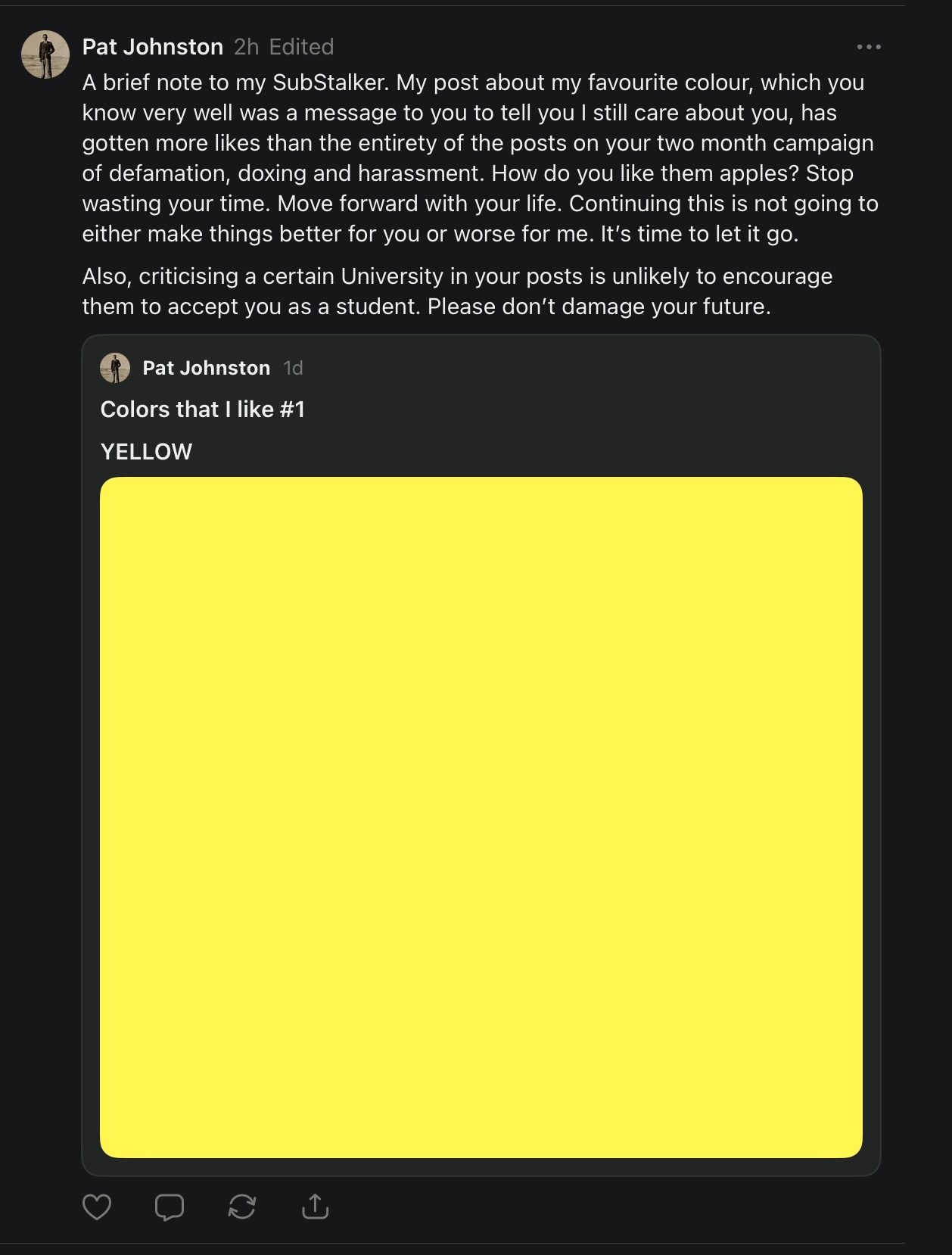Mr. J, a Former Professor Series – Entry 32: Defamation, Harassment, Doxxing Class 101
A special crash course for J (and the painfully slow learners’ club)
Public Note published by Pat Johnston (captured June 16, 2025; archived prior to deletion)
Oh yeah?
And what about your three months of harassing me nonstop? You forgot that part?
What about using your daughter to extort me and threaten my family?
What about publishing literary revenge porn using my name – on Substack, and in magazines?
You tell me.
TL;DR (quick summary below):
When people run out of arguments, they often misuse serious words to frame their critics as criminals. Let’s unpack what these terms actually mean.
Defamation refers to making a false statement presented as fact, which damages someone’s reputation and causes provable harm. The key point: it must be false. Truth is an absolute defense to defamation. If a claim is supported by evidence, such as messages, recordings, or public statements, it is not defamation — it is documentation.
Harassment involves repeated, unwanted, and targeted behavior that aims to intimidate, degrade, or threaten someone. Criticism, even if harsh, does not automatically count as harassment — especially if it is part of public commentary or self-defense, rather than direct personal targeting or threats.
Doxxing means publishing someone’s private, personally identifying information without consent and with malicious intent. However, when information was previously self-disclosed by the individual (for example, shared publicly by them), or if it is used in a journalistic or legal context with appropriate redaction, it does not meet the legal definition of doxxing.
People often weaponize these words to silence dissent or avoid accountability. By crying “defamation,” “harassment,” or “doxxing,” they attempt to paint themselves as victims and distract from the substance of the criticism.
Misusing these terms is not only intellectually lazy — it’s an insult to real victims of these actions. Calling a documented critique “defamation” or labeling evidence-based exposure as “doxxing” is like accusing a mirror of being violent simply because it reflects an uncomfortable reality.
TL;DR: Defamation, Harassment, Doxxing 101
What is defamation?
Defamation = false statement → damages reputation.
Must be false, stated as fact, and causes provable harm.
Truth is an absolute defense in defamation law.
If your statements are based on evidence, or you can prove them true (e.g., messages, recordings), it is not defamation.
What is harassment?
Harassment = repeated unwanted behavior intended to intimidate, scare, or degrade someone.
Must be unlawful, threatening, or create a hostile environment.
Publishing your own experience, analyzing public behavior, or expressing criticism is not necessarily harassment — especially if there’s no direct threat or repeated unwanted contact.
What is doxxing?
Doxxing = publicly revealing private, personally identifying information without consent, with malicious intent.
Examples: home address, private phone number, non-public documents.
If the information was already shared by the person themselves, or is used in a legal, journalistic, or public interest context (and properly redacted), it is not classic “malicious doxxing”.
Key clarifications
Criticism ≠ harassment.
Naming someone for public interest ≠ defamation, if factual.
Sharing already public or self-disclosed data (with context and disclaimers) ≠ doxxing in the legal sense.
Why do people misuse these words?
To silence critics (chilling effect).
To paint themselves as victims (narrative hijack).
To create fear-based compliance.
Note on Naming:
The subject of these verses is identified by name due to the severity of the public threats made during that period.
Naming is not intended to humiliate, but to preserve the integrity of the record and reflect the seriousness of the documented behavior.
While the individual has since responded publicly, the response has not addressed the core evidence. In such cases, visibility remains necessary. Selective rebuttal is not accountability.
Full evidence archive submitted to QPS, TEQSA, AHRC, and Ethics Australia: View here.
Cover image by BBC Creative via Unsplash.
For educational purposes only. Because some people clearly missed kindergarten lessons on basic ethics.
Read the full series
- Entry 1: The Man Who Taught Me Ethics by Failing All of Them
- Entry 2: The Disappearance of the Public Poet
- Entry 3: The Hanging Tree Case Study
- Entry 4: Hidden Like Accountability
- Entry 5: The Collapse of Assumptions
- Entry 6: The Ethics of a Tinder Bio
- Entry 7: How He Ate Told Me Everything
- Entry 8: What Makes a Scholar Dangerous
- Entry 9: Fragment of Life, Fragment of Accountability
- Entry 10: Anatomy of Disappointment
- Entry 11: Legal Defense Challenges: A Framing Statement
- Entry 12: Six Years After Ronell – What Academia Still Doesn’t Get
- Entry 13: QUT and The Man Who Raped Me
- Entry 14: Why Sarcasm Toward Institutions Can Backfire
- Entry 15: P*ssy or Toxic Masculinity?
- Entry 16: Who is Your Favorite Comedian?
- Entry 17: And What is Your Favorite Song?
- Entry 18: Grant Proposal — Narrative Ethics as Survivor-Led Forensics
- Entry 19: The Coward Behind the Clone
- Entry 20: [URGENT HIRE] CRISIS COMMUNICATIONS SPECIALIST
- Entry 21: [URGENT] Legal Counsel Needed for Complex Reputation Rehabilitation
- Entry 22: YOU’RE AN ABUSER. STOP CONTACTING ME
- Entry 23: Seeking Counsel for a Fallen Academic
- Entry 24: Internal Legal-PR Briefing
- Entry 25: For Journalists – Legal & Ethical Clearance Summary
- Entry 26: Symbolic Prostitution, Transactional Intimacy, or Just a “Loan”?
- Entry 28: Why He Simply Cannot Shut Up
- Entry 29: Forensic Commentary on “LARGE Language Muddle”
- Entry 30: Don’t Just Threaten My Future. Because I’m Going To Archive Your Present
- Entry 31: Open Letter to the Person Who Tried to Break Me with Defamation
- Entry 32: Defamation, Harassment, Doxxing Class 101
- Entry 33: Confidential Crisis Recovery Proposal
- Entry 34: Forensic Behavioral-Somatic Report
- Entry 35: Forensic Commentary on the Tattoos
- Entry 36: QUT and the Abuser They Once Had
- Entry 38: When Poetry Becomes Revenge Porn
- Entry 40: A Man Built for Applause, Not Accountability
- Entry 41: Neurobehavioral Addendum
- Entry 43: Why Does It Sound Like a War Metaphor?
- Entry 44: Forensic Commentary on Racialized and Fetishizing Language in “Hidden Like Rice”
- Entry 45: Public Misuse of Former Academic Affiliation
- Entry 46: The Two Things That Didn’t Leave a Bad Impression
- Entry 47: When Affection is Just an Alibi (A Bundy-Inspired Reflection)
- Entry 48: Humbert, Lolita, and the Fetish of Fragility
- Entry 49: The Fetish of Smallness as Symbolic Violence
- Entry 50: Motif Risk Analysis
- Entry 52: Can an Abuser Be a Good Father?
- Entry 53: Who Protects the Children?
- Entry 54: From Blackmail to Children
- Reflection: The Miscalculation
(More entries coming soon)
→ [Back to Start: Introducing Mr. J, a Former Professor Series]
© 2025 Linh Ng. All rights reserved.
This publication is intended for educational and reflective purposes only.
Sharing the original link is welcomed and encouraged.
Please do not reproduce, redistribute, or translate this content — in whole or in part — without written permission.
This piece reflects both lived experience and critical analysis. It is not meant to be detached from its author or reframed without context.
Misuse or decontextualization may lead to formal clarification or takedown requests.
This work has been reviewed and quietly followed by scholars, educators, and ethics professionals across multiple sectors.
If your institution is engaging in critical discourse around narrative justice, symbolic coercion, or representational ethics, feel free to connect via Substack DMs or formal channels.
A regulatory case regarding this matter has already been classified under a protected status within national education integrity systems.
Should any reputational countermeasures or distortions arise, I reserve the right to publish the documented timeline, behavioral patterns, and contextual metadata.
All relevant documentation has been submitted through formal legal and regulatory pathways.




